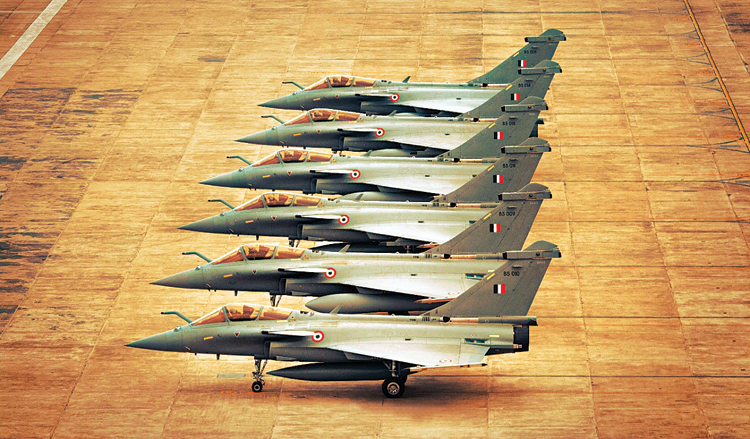SOURCE: AFI


India’s fighter aircraft fleet is currently facing a serious crisis, with the total number of operational fighter jets in the Indian Air Force (IAF) dipping below the levels seen during the 1965 war with Pakistan. This significant shortfall, exacerbated by ageing aircraft and delays in procurement, poses a direct threat to India’s national security, especially in the face of growing challenges from China and Pakistan.
The IAF’s sanctioned strength is supposed to be 42 squadrons, each with about 18-20 aircraft, but the number has dwindled to around 30 squadrons, and this figure could decline further if immediate action is not taken.
Prime Minister Modi’s government has until 2029 to address this issue. While the procurement of new fighter jets is a long and often bureaucratic process, there are several steps that can be taken to stabilize and even bolster the IAF’s fighter fleet within this timeframe.
India’s indigenous Light Combat Aircraft (LCA) Tejas Mk1A program offers a promising solution. The Mk1A version, developed by Hindustan Aeronautics Limited (HAL), is an upgraded version of the original Tejas, featuring modern avionics, air-to-air refueling, and advanced weapons systems. With 73 Tejas Mk1A already ordered, HAL needs to drastically increase production rates. HAL has committed to producing 16 aircraft per year, but a production rate of 24-30 jets annually would help meet IAF requirements faster. By 2029, around 100-150 Tejas Mk1As could potentially be inducted into the IAF, making it a key player in restoring squadron strength.
The Tejas Mk2, an upgraded version of the Tejas platform, is expected to feature a more powerful GE F414 engine, enhanced payload capacity, and better range. This aircraft is still under development, but speeding up its development and production could allow the IAF to induct its first Mk2 squadrons by the late 2020s or early 2030s, easing long-term pressure on the Su-30MKI fleet.
The Rafale jets acquired from France have proven to be highly effective, with 36 aircraft already inducted into the IAF. Expanding this fleet could be one of the quickest ways to add high-performance fighter jets to the IAF. The Indian government can fast-track negotiations with France for the procurement of an additional 36 Rafale jets, which could be delivered by 2029. This would bring the total Rafale fleet to 72, enhancing the IAF’s combat capabilities.
The MRFA program, which aims to procure 114 jets through a global tender, has been delayed for years. However, if the government can expedite this process, the first deliveries could begin in the latter part of this decade. The contenders for this program include the Rafale, Boeing F-15EX, F/A-18 Super Hornet, Saab Gripen, and Eurofighter Typhoon. Whichever jet is selected, its local production in collaboration with Indian private industry could be accelerated to ensure timely delivery.
India’s Advanced Medium Combat Aircraft (AMCA) is a 5th-generation stealth fighter being developed by the Aeronautical Development Agency (ADA). The AMCA is expected to replace the IAF’s aging fleet and provide a significant technological leap.
While the AMCA’s first flight is projected for 2028-29, efforts should be made to bring this timeline forward. Allocating more funds and resources to the project could allow the IAF to induct AMCA by the early 2030s, making it a crucial component of India’s airpower.
To bridge the gap until new aircraft arrive, Su-30MKIs and Mirage-2000 fighters, the workhorses of the IAF, could undergo upgrades to extend their operational life and improve their capabilities. The Su-30MKIs can be upgraded with new radar, avionics, and weapon systems to improve their capabilities. HAL has already begun work on a ‘Super Sukhoi’ upgrade program, which should be accelerated.
Similarly, the Mirage-2000 fleet can undergo life extension programs to ensure that these aircraft remain operational through the late 2020s and 2030s.
If procurement timelines are too long, the Indian government could consider leasing fighter jets from other countries, a method that has been successfully employed in the past. Leasing jets, such as Gripen or F-16, could help bridge the gap in squadron strength until indigenous production ramps up.
Prime Minister Modi’s government faces an uphill battle to restore the Indian Air Force’s fighter strength by 2029. However, a combination of strategies—including ramping up Tejas Mk1A production, procuring more Rafale jets, fast-tracking the MRFA program, and accelerating AMCA development—can provide the IAF with the much-needed firepower to defend India’s skies.